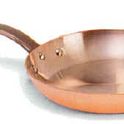Best Font for Printed Recipes: I'm assembling about 100 printed family favorites as a gift for a special family member. What font should I use? Why?
Thank you so much, everyone. ;o) P.S. I'm creating a password-protected web-based version as well, so other family members can add to it, update recipes, etc.
25 Comments
Rumeysa N.March 29, 2016
I have used "Signika" font family for recipes in My Web site: http://lezzetkat.com. Have a good design, well-shaped and great UX for my site.
PegeenFebruary 14, 2014
p.s. Since all will be typed out, a blog or web site would be a good idea for the younger generation(s). WordPress is an easy solution for blogging.
PegeenFebruary 14, 2014
Antonia, just read your post from earlier today. I know I speak for many when I wish you every success with this wonderful project. What a lovely, timeless gift for your family. I've never met anyone who doesn't treasure their family's tattered copies of recipes - how nice to have a stable copy. Truly a gift from the heart.
I've made a project with my nieces and nephews to cook my Mother's and Grandmothers' key recipes with them. They know my Mother well, but did not know their Great-grandmothers, and seem to love that bit of connection with the past.
I've made a project with my nieces and nephews to cook my Mother's and Grandmothers' key recipes with them. They know my Mother well, but did not know their Great-grandmothers, and seem to love that bit of connection with the past.
PegeenFebruary 14, 2014
bigpan, I hear you, but science and the miracle of modern research tells us that consistency and a serif font increases readability. In my humble opinion, the most important thing to spend time on is 1) accuracy of the recipe, 2) any helpful first-hand notes and 3) a very good table of contents or index.
AJ, the most important thing regarding color is that people will be photocopying this book. So using grey shades vs color, or limiting color to something that reproduces well (do photocopying and shade % tests with colors that appeal), is a helpful way to go for your readers.
AJ, the most important thing regarding color is that people will be photocopying this book. So using grey shades vs color, or limiting color to something that reproduces well (do photocopying and shade % tests with colors that appeal), is a helpful way to go for your readers.
bigpanFebruary 14, 2014
I would use about a dozen different fonts. Make each recipe stand out from the previous or next. Adjust the size so that each becomes as easy to read as the next.
MaedlFebruary 14, 2014
I have often thought about that and wondered who shouldered the responsibility. And why didn't someone catch it when the page proofs came in?!
MaedlFebruary 14, 2014
Another thing I just thought of: beware of yellow. One of Gourmet's books published during Ruth Reichl's tenure used yellow titles or subtitles, which were totally illegible due to lack of contrast.
AntoniaJamesFebruary 14, 2014
Yes, Maedl, I agree 100%. I have that book and I so wish I could just "select all" and click on a darker color to make the pages more legible. I simply cannot understand how a rookie error with such impace was made by an established publisher such as Gourmet! ;o)
AntoniaJamesFebruary 14, 2014
Thanks so much, everyone. Every bit of this advice is helpful. Pegeen (and anyone else who is interested), feel free to contact me directly via the messaging system within my profile. I'll make a Google Doc of the book available to invited Food52 guests only, not-editable, of course, though I may set up a separate, editable comments page for each recipe for questions/discussion, etc., to see how that works. (It may need to be a separate file; I haven't worked with Google Docs for this kind of project.) My personal deadline for the project is mid-May. The primary "giftee" is the newest member of our extended family, who hasn't been born yet and is a week overdue today -- my father's first great grandchild. Two of his grandchildren will be graduating from college in June, so the mid-May go-live will celebrate those milestones as well. It's quite possible that the collection will end up having closer to 200 recipes. Many are directly or derived from my late Mother's collection of family favorites I still make all the time, especially the holiday treats. I've carried the torch on those for many years. (I actually was interviewed by Leonard Lopate and Melissa Clark about that a few years ago on the PBS radio station in NYC.) In any event, it promises to be tremendously fun. My goal is to create a cookbook as good if not better -- in the ways that matter to me -- than the Food52 Cookbooks, and any comparable entry into this or any prior year's Piglet. With encouragement, I may venture into the land of e-Books, assuming I can figure out how to leap the copyright hurdles. ;o)
kimhwFebruary 15, 2014
How do you private message through this site? I would love to read this book!
A few years ago, I went a different route. I collected for various older family members they original handwritten, or ones if their parent. I had high quality copies of the hand written, scribbled on, stained and dirty recipes blown up and bound for everyone. Not quite as practical, but beautiful to see all the time the recipes were made and the love.
Your children, nieces and nephews will love this gift you are about to give them.
A few years ago, I went a different route. I collected for various older family members they original handwritten, or ones if their parent. I had high quality copies of the hand written, scribbled on, stained and dirty recipes blown up and bound for everyone. Not quite as practical, but beautiful to see all the time the recipes were made and the love.
Your children, nieces and nephews will love this gift you are about to give them.
MaedlFebruary 14, 2014
I definitely agree with choosing a serifed font for the main text--legibility is key. Be sure that whatever font you choose has all the symbols you will need. If you want the page to look more interesting, you could use a sans serif font for recipe titles. If you use color, limit yourself to one color other than black. You may want to make up a style sheet so you remain consistent throughout the book. You might also check out Diane Jacobs' website--I think she has posted much on how to write and design recipes.
SKKFebruary 14, 2014
This is probably an an age thing. What works best for me to see and work with is Verdana. It appeals to all generations in my family. Garamond and Helvetica et al are difficult to read, in my view. Pun intended.
LeBec F.February 14, 2014
aj, i forgot to mention that you might want to think about the format being a ring binder, with each recipe in a plastic sleeve and 2-pg recipes placed back to back in one sleeve.
kimhwFebruary 14, 2014
Do all foodies have or have had graphic, marketing or publishing careers????
Just in case someone reading this doesn't know, serifs are feet on your letters.
Your font size is the size on your letters.
I'm assuming this is for multiple generations, make the font as large as you can and keep it on minimum pages. There is nothing worse than having your hands very busy in a critical step if a recipe and unable to read the next step from where you are in the kitchen.
Just in case someone reading this doesn't know, serifs are feet on your letters.
Your font size is the size on your letters.
I'm assuming this is for multiple generations, make the font as large as you can and keep it on minimum pages. There is nothing worse than having your hands very busy in a critical step if a recipe and unable to read the next step from where you are in the kitchen.
PegeenFebruary 14, 2014
A lof of them did! I worked for Int'l Typeface Corp and Bitstream, both renowned font foundries. Have to say, though, I have a feeling Ed Rondthaler would be twitching in his grave to hear serifs called "feet on your letters." ;-)
sexyLAMBCHOPxFebruary 14, 2014
Also be mindful of the recipient. If vision is problematic perhaps go with a larger font size.
PegeenFebruary 14, 2014
p.p.s. What do I have to do, to get a copy of your book?!
PegeenFebruary 14, 2014
p.s. My first job was working for the hottest type shop in NYC, that did all the work for the hottest ad agencies.
PegeenFebruary 14, 2014
A "default" font that works on both PCs and Apple platforms, is best, since now and the future is online vs paper. All font scientists will tell you that a serif font is more readable than sans serif.
LeBec F.February 13, 2014
aj, you always strike me ass a very smart woman, so you peob alrdy had this planned, but my advice would be to:
Choose a sample recipe. Cut and paste the last few lines of ingredients (including numbers)and the first paragraph of recipe instructions into a document or email.
do this as many times as there are fonts rec'd by nerdling.
now highlight and choose a diff nerdling font for @ sample.
see what feels most like the personality
you want in this project. check for easy legibility and that includes SIZE of text. Choose!
That said, Garamond has always been my fav font. But it's not as hefty as Times Roman for example.
Choose a sample recipe. Cut and paste the last few lines of ingredients (including numbers)and the first paragraph of recipe instructions into a document or email.
do this as many times as there are fonts rec'd by nerdling.
now highlight and choose a diff nerdling font for @ sample.
see what feels most like the personality
you want in this project. check for easy legibility and that includes SIZE of text. Choose!
That said, Garamond has always been my fav font. But it's not as hefty as Times Roman for example.
nerdlingFebruary 13, 2014
I would choose something serifed, because serifs are easier on the eyes and make word recognition much simpler. For the classic, you can't go wrong with Caslon, Garamond or Baskerville (provided you have a version of the font that uses lining figures rather than old-style), or I'm a big fan of Hoefler Text. If you'd like something that looks more modern, try Didot or Archer. As a bonus, you should be able to find versions of all of them that support fractions so your recipes can be properly typeset.
If you're really prefer to a sans-serif, I'd avoid Helvetica and go for something less popular like Avenir or Gill Sans.
If you're really prefer to a sans-serif, I'd avoid Helvetica and go for something less popular like Avenir or Gill Sans.
nerdlingFebruary 14, 2014
P.S. Be sure to pick your longest and/or most difficult recipe to lay out as a sample. Nothing worse than getting twenty percent done with a project like this and realizing the format you worked so hard on isn't going to work with some of your recipes!
Showing 24 out of 25 Comments
Recommended by Food52
Popular on Food52
Continue After Advertisement





